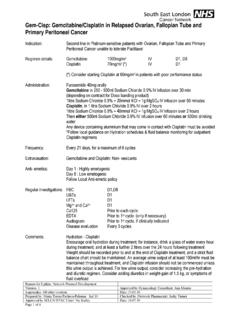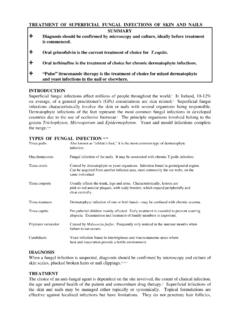Transcription of INTERACTIONS BETWEEN ANTIHYPERTENSIVE AGENTS …
1 IntroductionThe vast majority of hypertensive patients is treatedwith ANTIHYPERTENSIVE drugs for many years. Othertherapeutic AGENTS are frequently used simultaneously,thus giving rise to the possibility of drug-drug interac-tions. The potential for drug-drug INTERACTIONS increas-es with rising age, since elderly patients receive largernumber of drugs, but also because the renal excretionof several therapeutic AGENTS is impaired in the elderly,as a result of diminishing kidney function (1, 2). Theinteractions BETWEEN ANTIHYPERTENSIVE drugs and othertherapeutic AGENTS will be discussed and summarizedin the present issue, after a brief general explanationof the various mechanisms underlying drug-drug inter-actions.
2 The combination and mutual interactionsbetween various categories of ANTIHYPERTENSIVE agentswill be dealt with by us in a separate issue of thisnewsletter. MechanismsThere are several mechanisms by which drugs mayinteract (3-5), and most of these mechanisms can becategorized as pharmacokinetic (involving intestinalabsorption, distribution, metabolism, and elimination)or as pharmacodynamic, or as additive toxicity, INTERACTIONS : the interaction in intes-tinal absorptionis best illustrated by an example: tetra-cylines and other broad-spectrum antibiotics mayimpair the absorption of oral contraceptives (in particu-lar those with low-dose progestogens and/or estro-gens) and hence render contraception unsafe.
3 Severaldrugs are subject to inactivation via metabolic degra-dationit the liver, catalysed by various liver formation of these enzymes can be induced orenhanced by drugs such as rifampicine, griseofulvine,and several anti-epileptics (carbamazepin, phenytoine,phenobarbital), but also by regular alcohol consump-tion. This process, which requires several weeks oftreatment and which is indicated as enzyme induction,enhances the metabolic degradation of several practice, enzyme induction may play a relevant rolefor oral anticoagulants (coumarin type), corticosteroids(glucocorticoids), oral contraceptives, or , these categories of drugs are metabo-lized/inactivated more rapidly and their doses shouldtherefore be increased.
4 A comparable but oppositeproblem is the inhibition of liver enzymesinvolved inthe biotransformation by a variety of drugs, such ascimetidine, erythromycin, metronidazole, tricyclic anti-depressants, phenothiazine-neuroleptics, andsulphonamides (also in co-trimoxazole). Enzymeinhibitors of this type impair the biodegradation of cer-tain drugs and hence increase their effects. A well-known problem is the enhanced effect of anticoagu-lants (as reflected by bleeding) induced by additionaltreatment with co-trimoxazole. Certain drugs mayimpair the renal excretion(3-5) of other AGENTS , usuallyat the renal tubular level.
5 A well-known relevantexample is the rise in the plasma level and toxicity ofdigoxin, provoked by verapamil, amiodarone, or quini-dine. Similarly, thiazide diuretics may decelerate therenal elimination of lithium salts and hence reinforcetheir toxicity. A beneficial effect of such an interactionis the impaired excretion of penicillin antibioticsinduced by simultaneously administered INTERACTIONS and additive toxicity(3-5: Pharmacodynamic INTERACTIONS BETWEEN similarlyacting drugs may lead to additive or even over-additiveeffects (potentiation). A well-known example is thecombination of verapamil and a -blocker, whichmay cause additive impairment of cardiac A-V conduc-tion and the risk of A-V block.)
6 Another possibility is theinhibition of the therapeutic effect of a drug by an addi-tional agent . Over-additive adverse reactions are illus-trated by the following example: a most importantinteraction, probably caused by non-specific mecha-nisms, is the mutual enhancement of the central nerv-ous depressant effects of all drugs that are known todampen the activity of the central nervous interaction holds for hypnotics, anxiolytics (minortranquillizers), antipsychotics (neuroleptics, major tran-quillizers), anti-epileptics, and opioids, but also fordrugs with central nervous depressant adverse reac-tions, such as antihistamines, centrally acting antitus-sives (codeine, etc.)
7 , and scopolamine (3-5, 9).Furthermore, alcohol enhances the central nervousdepressant effects of all of the aforementioned thera-peutics. Accordingly, enhanced sedation, impairedpsychomotor skills (driving), but also respiratorydepression may AGENTS and other drugsThe most relevant INTERACTIONS BETWEEN antihyperten-sive and other drugs have been listed in the Table 1,and the effect of these INTERACTIONS on blood pressurein the Table few comments may be made: it goeswithout saying that a combination of two or more anti-hypertensive AGENTS may be expected to cause anadditive blood-pressure lowering effect, to be dis-2003; 4: No.
8 17 INTERACTIONS BETWEEN ANTIHYPERTENSIVE AGENTS AND OTHER DRUGSP eter A. van Zwieten, Departments of Pharmacotherapy, Cardiology and Cardio-Thoracic Surgery, AcademicMedical Centre, The Netherlands, and Csaba Farsang, 1st Department of Internal Medicine, St. Imre Hospital,Budapest, HungaryNewsletter 10:47 Page 1cussed in more detail in a forthcoming issue of thisnewsletter. Central nervous depressant effects of alldrugs suppressing the activity of the central nervoussystem enhance the side effects of centrally actingantihypertensives (reserpine, alpha-methyldopa, guan-facine, clonidine) (3-5, 9).
9 More recently, a great dealof attention has been paid to the interaction betweenantihypertensive drugs and NSAID's. Example:indomethacin and other nonsteroidal antiinflammatorydrugs (NSAID's) may counteract the antihypertensiveeffects of thiazide diuretics, -blockers, ACE-inhibitorsand AT1-receptor antagonists, as a result of sodiumand fluid retention as well as of decreased formationof vasodilatory prostaglandins (6,7). It has been clearlydemonstrated, however, that low-dose acetylsalicylicacid (ASA; Aspirin , 75 mg daily) does not interferewith the ANTIHYPERTENSIVE activity of ACE-inhibitors andother types of ANTIHYPERTENSIVE drugs (8).
10 References1. Popplewell PY, Henschke PJ. Acute admissions to a geriatric assessmentunit. Med J Aust 1982; 1: 343 - Williamson J, Chopin JM. Adverse reactions to prescribed drugs in the elderly: a multicenter investigation. Age Ageing 1980; 9: 73 - Hansten PhD. Important drug INTERACTIONS . In: Katzung BG (Ed). Basic andclinical pharmacology. Prentice-Hall Int, Englewood Cliffs NJ, USA, 5th Ed,1992; pp 931 - Stockley IH. Drug INTERACTIONS . Pharmaceutical Press, London, 5th Ed, Opie LH. Cardiovasscular drug INTERACTIONS . In: Messerli FH (Ed).Cardiovascular drug therapy.

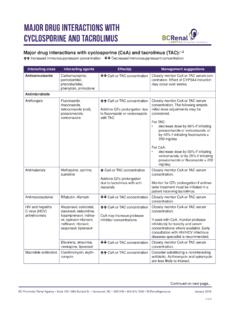

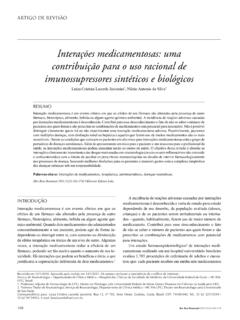

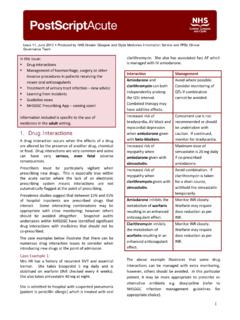
![BNF 75 (British National Formulary) March 2018 [Ed. 75]](/cache/preview/b/e/8/7/9/4/f/d/thumb-be8794fdf07a06a84c5c74e9f01f1b3f.jpg)
